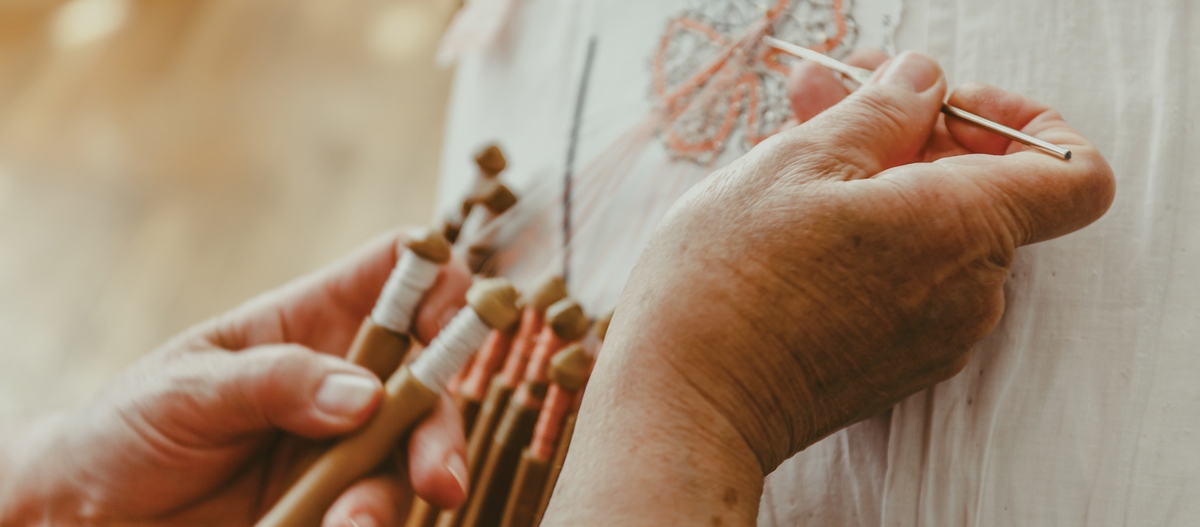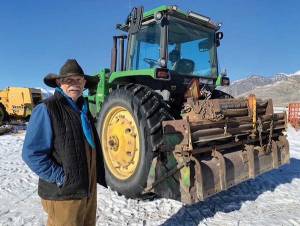APPALOOSA LACE GUILD PR
Cathy DiNoto has osteoarthritis, but that doesn’t stop her from her favorite handcraft: bobbin lace weaving. She braids and twists pairs of threads into complex patterns, held in place by pins, to create intricate, yet sturdy lace.
“For an older person, like I am, with terrible osteoarthritis, it keeps you fit,” said the 72-year-old central Idaho resident, who has been weaving for around 10 years. She may not be able to knit or crochet anymore, said DiNoto, but bobbin lace weaving doesn’t impact her condition one bit.
She’s not alone. After breaking her wrist, fellow Appaloosa Lace Guild member Joy Irving surprised the doctor removing her cast with her near-perfect range-of-motion. She attributes that to bobbin lace weaving, which she did even with her cast on.
“It helps to reduce the arthritis in your fingers,” said Irving, who grew up doing embroidery. She tried her hand at tatting—a lacemaking technique using shuttles to loop and knot the thread into patterns, similar to macramé—and discovered bobbin lace around 1995.
She likes to wear the lace items she has created over the years.
Bobbin lace weaving as a therapeutic modality? Probably not. DiNoto is convinced, however, that bobbin lace weaving keeps her mind agile.
“I’ve taught it to some people, who look at me after an hour and say, ‘you got rocks in your head,’” said DiNoto. Her largest piece involved 78 pairs of bobbins—156 threads at any given time, looking more like an impossible wiring schematic than the delicate and durable lace it would become.
Keeping the bobbins in the right order, following the pattern, and fixing mistakes that might occur are all time-consuming and require a lot of mental focus, which DiNoto finds relaxing.
“It’s like a puzzle,” she said. She often makes her own patterns and keeps much of her lacework in a scrapbook.
DiNoto got into lace bobbin weaving after her daughter—who is also in the Guild—saw a demonstration at the Latah County Fair. DiNoto, a former junior high chemistry teacher who has always done handcraft, took to it immediately. So much so, in fact, that she was one of only three out of 1,100 members across 24 countries to achieve proficiency in a particular kind of lace called torchon through the International Organization of Lace, Inc. (IOLI).
There are numerous techniques for making lace, evidence of which dates to ancient Egypt and appeared on ecclesiastical garments in the 12th and 13th centuries. It was popularized in the 16th and 17th centuries, when lace was used as a trim for collars and cuffs, later becoming a much-sought-after fashion item.
All lacemaking uses thread, but tools, techniques, and outcomes vary widely.
Needle lace, for example, involves a needle, very fine thread, and extremely elaborate stitching, while tatting and macramé use knots to create the lace pattern and allow for heavier thread. Lace can also be created by cutting out sections of fabric, knitting, and crocheting.
Bobbin lace, on the other hand, is a weaving technique that requires certain movements: a half- or full-cross or twist. The intricacy comes in following the pattern, which is pinned to a pillow (bobbin lace is also known as pillow lace). Bobbins hold the thread, keeping it clean and taut as the design is worked. The bobbins might be as simple as a lathe-turned piece of wood, sometimes embellished with beads, or as elaborate as hand-carved bone or ivory, giving rise to another moniker: bone lace.
“It is kind of an expensive hobby,” said Irving, who tried to teach herself the technique while living in Moscow, Idaho, and lucked out to discover a woman teaching bobbin lace in Texas where she’d relocated temporarily with her husband.
“I figured I needed to learn all I can, because there wasn’t anyone in Moscow doing bobbin lace,” said Irving, who was surprised and delighted to discover the Appaloosa Lace Guild.
The Guild has roughly 15 members throughout Idaho, Montana, and Washington, and gets together quarterly. Members participate in local events—they did demonstrations at the recent Moscow artwalk—and gather materials for displays like at Spokane International Airport, which occurred prior to the IOLI conference held in Spokane this year. They also share techniques and welcome people interested in learning about lace, to whom they make kits available.
“We try to cover all the different types, so people have an opportunity to learn all of them,” said Irving. ISI










